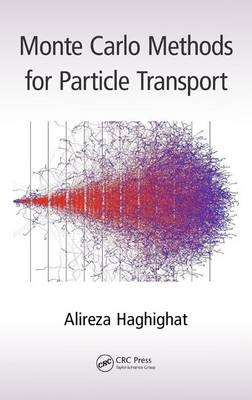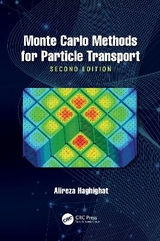
Monte Carlo Methods for Particle Transport
Crc Press Inc (Verlag)
978-1-4665-9253-7 (ISBN)
- Titel erscheint in neuer Auflage
- Artikel merken
Monte Carlo Methods for Particle Transport teaches appropriate use of the Monte Carlo method, explaining the method’s fundamental concepts as well as its limitations. Concise yet comprehensive, this well-organized text:
Introduces the particle importance equation and its use for variance reduction
Describes general and particle-transport-specific variance reduction techniques
Presents particle transport eigenvalue issues and methodologies to address these issues
Explores advanced formulations based on the author’s research activities
Discusses parallel processing concepts and factors affecting parallel performance
Featuring illustrative examples, mathematical derivations, computer algorithms, and homework problems, Monte Carlo Methods for Particle Transport provides graduate students and nuclear engineers and scientists with a practical guide to the application of the Monte Carlo method.
Alireza Haghighat is a professor at Virginia Tech. He has served as the director of the Nuclear Science and Engineering Lab in Arlington, Virginia, and led the Virginia Tech Theory Transport Group. He previously worked at Penn State and the University of Florida. He holds a Ph.D from the University of Washington. He has published numerous papers, received several best paper awards, and presented many invited workshops, seminars, and papers nationally and internationally. He is a recipient of the 2011 Radiation Protection Shielding Division’s Professional Excellence Award, and a recognition award from the Office of Global Threat Reduction. An ANS fellow, he has served in various ANS leadership positions.
Acknowledgments
About the Author
Introduction
History of Monte Carlo Simulation
Status of Monte Carlo Codes
Motivation for Writing This Book
Overview of the Book
Recommendations to Instructors
Author's Expectation
References
Random Variables and Sampling
Introduction
Random Variables
Discrete Random Variable
Continuous Random Variable
Notes on pdf and cdf Characteristics
Random Numbers
Derivation of the Fundamental Formulation of Monte Carlo (FFMC)
Sampling One-Dimensional Density Functions
Analytical Inversion
Numerical Inversion
Probability Mixing Method
Rejection Technique
Numerical Evaluation
Table Lookup
Sampling Multidimensional Density Functions
Example Procedures for Sampling a Few Commonly Used Distributions
Normal Distribution
Watt Spectrum
Cosine and Sine Function Sampling
Remarks
References
Problems
Random Number Generation (RNG)
Introduction
Random Number Generation Approaches
Pseudorandom Number Generators (PRNGs)
Congruential Generators
Multiple Recursive Generator
Testing Randomness
x2-Test
Frequency Test
Serial Test
Gap Test
Poker Test
Moment Test
Serial Correlation Test
Serial Test via Plotting
Examples for PRNG Tests
Evaluation of PRNG Based on Period and Average
Serial Test via Plotting
Remarks
References
Problems
Fundamentals of Probability and Statistics
Introduction
Expectation Value
One-Dimensional Density Function
Multidimensional Density Function
Useful Theorems Associated with the "True Variance"
Definition of Sample Expectation Values Used in Statistics
Sample Mean
Expected Value of the Sample Variance
Precision and Accuracy of a Statistical Process
Uniform Distribution
Bernoulli and Binomial Distributions
Geometric Distribution
Poisson Distribution
Normal ("Gaussian") Distribution
Limit Theorems and Their Applications
Corollary to the de Moivre-Laplace Limit Theorem
Central Limit Theorem
Formulations of Uncertainty and Relative Error for a Random Process
General Random Process
Special Case of Bernoulli Process
Confidence Interval for Finite Sampling
Introduction to Student's t-Distribution
Determination of Confidence Interval and Application of the t-Distribution
Test of Normality of Distribution
Test of Skewness Coefficient
Shapiro-Wilk Test for Normality
References
Problems
Integrals and Associated Variance Reduction Techniques
Introduction
Estimation of Integrals
Variance Reduction Techniques Associated with Integrals
Importance Sampling
Correlation Sampling Technique
Stratified Sampling Technique
Combined Sampling
Remarks
References
Problems
Fixed-Source Monte Carlo Particle Transport
Introduction
Introduction to the Linear Boltzmann Equation
Introduction the Monte Carlo Method
Determination of Free Flight, i.e., Path-Length
Selection of Interaction Type
Selection of Scattering Angle
A Monte Carlo Algorithm for Estimation of Transmitted Particles
Perturbation Calculations via Correlated Sampling
Analysis of Monte Carlo Results
Remarks
References
Problems
Variance Reduction Techniques in Particle Transport
Introduction
Effectiveness of Variance Reduction Algorithms
Biasing of Density Functions
Implicit Capture (or Survival Biasing)
Russian Roulette
Biasing the Path-Length to the Next Collision
Exponential Transformation
Forced Collision
Splitting Techniques
Geometric Splitting with Russian Roulette
Energy Splitting with Russian Roulette
Angular Splitting with Russian Roulette
Weight-Window Technique
Application of Combination of Importance Sampling, pdf biasing, and Splitting Technique in Particle Transport
Importance (Adjoint) Function Methodology in Deterministic Transport Theory
Determination of Detector Response
Use of Deterministic Importance (Adjoint) Function for Importance Sampling
Remarks
References
Problems
Tallying
Introduction
Major Quantities in a Particle Transport Simulation
Tallying in a Steady-State System
Collision Estimator
Path-Length Estimator
Surface-Crossing Estimator
Analytical Estimator
Tallying in a Time-Dependent System
Tallies in Nonanalog Simulations
Estimation of Relative Error Associated Physical Quantities
Propagation of Error
Remarks
References
Problems
Geometry and Particle Tracking
Introduction
Discussion on a Combinatorial Geometry Approach
Definition of Surfaces
Definition of Cells
Examples
Description of Boundary Conditions
Particle Tracking
Remarks
References
Problems
Eigenvalue or Criticality Monte Carlo Particle Transport
Introduction
Theory of Power-Iteration for Eigenvalue Problems
Monte Carlo Eigenvalue Calculation
Random Variables Associated with a Fission Process
Direction of Fission Neutrons
Monte Carlo Simulation of a Criticality Problem
Estimators for Sampling Fission Neutrons
Issues Associated with the Standard Eigenvalue Calculation Procedure
Diagnostic Methods for Source Convergence
Fission Matrix (FM) Methodology
Issues Associated with the FM Method
Remarks
References
Problems
Vector and Parallel Processing of Monte Carlo Methods
Introduction
Vector Processing
Vector Performance
Parallel Processing
Parallel Performance
Vectorization of Monte Carlo Methods
Parallelization of the Monte Carlo Methods
Other Possible Parallel Monte Carlo Algorithms
Development of a Parallel Algorithm Using MPI
Remarks
References
Problems
Appendices One to Six
| Zusatzinfo | 1/16- SENT FILE TO PG AGAIN; 514 Equations, 1 in text box; 42 Tables, black and white; 75 Illustrations, black and white |
|---|---|
| Verlagsort | Bosa Roca |
| Sprache | englisch |
| Maße | 156 x 235 mm |
| Gewicht | 567 g |
| Themenwelt | Mathematik / Informatik ► Mathematik |
| Naturwissenschaften ► Physik / Astronomie ► Atom- / Kern- / Molekularphysik | |
| Naturwissenschaften ► Physik / Astronomie ► Hochenergiephysik / Teilchenphysik | |
| Technik ► Umwelttechnik / Biotechnologie | |
| ISBN-10 | 1-4665-9253-2 / 1466592532 |
| ISBN-13 | 978-1-4665-9253-7 / 9781466592537 |
| Zustand | Neuware |
| Haben Sie eine Frage zum Produkt? |
aus dem Bereich



